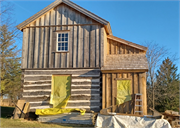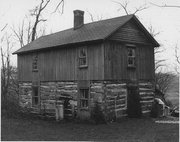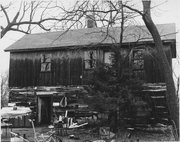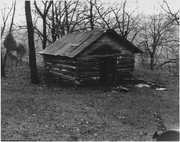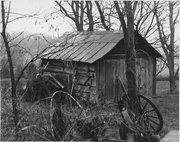| Additional Information: | A 'site file' exists for this property. It contains additional information such as correspondence, newspaper clippings, or historical information. It is a public record and may be viewed in person at the Wisconsin Historical Society, Division of Historic Preservation-Public History.
Few parts of the United States are more Norwegian than the Mount Horeb area. The chain of Norwegian immigration to this area began about 1846, when two men originally from Valdres, a valley region in south-central Norway, spent some time here. They sent encouraging letters back home, prompting Aslak Olsen Lie to bring a larger party of emigrants. Lie’s group established the community of East Blue Mounds, the first Norwegian settlement in western Dane County, in 1848.
In his homeland, Lie had been a master carpenter, cabinetmaker, and blacksmith. But in America, he had to work with unfamiliar materials, so in building his cabin, Lie combined old-country traditions with American techniques. The cabin’s first story reflects the traditional log architecture of rural Norway. Lie joined the logs by chiseling the ends into dovetails, and he filled the chinks with wood, likely covered with mortar or clay to keep out the wind. But, because he found it difficult to hew the local oak, a much harder wood than Norwegian fir and spruce, for the second story he used oak-timber framing with vertical siding, a construction method virtually unknown in Norway. Along with the siding, Lie also installed American-style double-hung windows on the second floor. But he retained the traditional room arrangement inside: kitchen to the left, living room to the right, two bedrooms upstairs. Lie’s handmade decorative woodwork and hardware survive inside. The exterior, too, reflects his attention to ornamental detail: note the sawtooth molding beneath the cornices of the gable ends.
The house once had a two-story sval, an exterior passageway common to Norwegian dwellings, which ran almost the whole length of the south elevation, extending a few feet beyond the west wall. A subsequent owner removed the sval and made windows out of some doorways that once opened onto it. The Norwegian double-casement windows that Lie used in the log portion of the house are also gone, and a new window has been cut into the center of the second story. Still, the Lie Cabin retains most of its original character. One of the oldest Norwegian American buildings in Wisconsin, it is visited each year by scores of Norwegians from Lie's hometown.
See inventory 0607-04; research by Jack Holzheuter on family.
Dates of significance: 1875-1899. Associated person: Aslak Lie, 1814.
Dismantled in 2003 and moved to Folklore Village located in Dodgeville, Iowa County. Currently waiting on funding to reassemble (2009).
Was located at 3022 COUNTY HIGHWAY P in the Town of Springdale, WI. Moved to 3210 County Road BB in Dodgeville, WI (Folklore Village).
Additional Information, 2024:
Architecture:
The Aslak Lie Cabin is a two-story rectangular building that is being reconstructed to its supposed 1848-1849 appearance based on a c.1880 photograph by Andreas Dahl, a noted Dane County photographer. The building is being reconstructed using materials still extant in 2002 when it was moved, along with replacement materials for elements that could not be used. Using this historic photograph as a guide, the original “sval” or exterior hallway ell is also being reconstructed using replacement materials.
The building has a first story constructed of logs that feature dovetail corners and wide chinking between the logs. The reconstruction of this story used as many logs from the original building as possible, but there are some replacement logs. There are several openings that punctuate the log walls. The c.1880 photograph shows the window openings were filled with paired multi-light casements. Entrances are not seen in the historic photograph, but photographs from the 1980s and the early 2000’s show several entrances, one on an end wall and two on a side wall. On the other side wall, shown in photographs taken in the early 2000’s, larger entrances that were enclosed with vertical boards are seen. The first story window openings in the 1980s and 2000’s photos show that they were filled with a variety of double-hung sashes. The current first story window openings are awaiting replica replacements, presumably similar to the ones seen in the c.1880 photo.
In the current restoration of the building, the entrances are confined to the reconstructed “sval” or shed-roofed ell that runs along one side of the log structure. The sval has three entrances, two with transoms. The third entrance on the end wall is in a shed-roofed enclosed entry ell connected to the sval. The sval walls are clad with both board and batten siding, vertical wood boards and plywood.
The second story sits under a gable roof covered with wood shingles. This story is clad with board and batten siding. The board and batten siding may have been used for the exterior because the 1986 National Register nomination indicates that it was placed on the entire building around 1880 but removed in the 1970s on the first floor. (Note: since no 20th century photographs exist of board and batten siding, it is also assumed that the battens were taken off of the second story when the siding was removed from the first story to “return the building to more of its original appearance.” It is not clear why the board and batten siding was used in the current restoration effort as the historic photo is unclear, but looks like only vertical boards were used as siding without battens. The current siding with large battens is very distinct and may not be appropriate.) The current window openings in the second story are filled with six-over-six-light sashes replicated from the c.1880 photograph.
The interior of the sval is a hallway with entrances into the first floor of the cabin. The sval contains a simple wood staircase leading to the second story of the building. There are no good photographs of the first floor of the building, but a couple of 1980s views show exposed log walls. The 1986 National Register nomination states that the building that time had two rooms on the first floor, a kitchen and living room with an enclosed staircase to the second floor as the sval was not extant at that time. One architectural detail still extant is an interior door, of heavy wood construction with two panels and distinctive diamond engravings. The second floor of the building shows the framing of this story, but there is no finishing as the building is still under reconstruction. The national register nomination states that this floor also had two rooms and a hallway. One room was covered with wainscoting, while the other had some extant wallboard.
History
Aslak Lie was born in 1798 in Hofseie, South Aurdahl, Norway to a family of non-landowners. He was fortunate to learn to read and write and joined the local militia. We also worked as a cabinet maker and carpenter and eventually grew to own his own farm property in the Valdres area of Norway. In 1848 he led a group from Valdres that immigrated to western Dane County in the Blue Mounds-Mt. Horeb area. He built this house and continued to work as a cabinet maker and carpenter. He gained a reputation for quality work that has been passed down and analyzed by folk art historians. He lived in this property until around 1878, then moved to live with his son in Buffalo County, Wisconsin, where he died.
Beginning in the 1960s, the building stood vacant and was neglected over the years; the sval was removed and the building deteriorated. It was listed in the National Register in 1986 and stood on its original site until 2002-2003, when it was dismantled for an anticipated move to the property of Folklore Village near Dodgeville. Delays in reconstructing the building left it in storage until 2014, when a plan was made to raise funds for restoration. The building is now almost completely reconstructed and Folklore Village plans on opening it to the public in the spring of 2025.
Carol Cartwright, 2024
|
|---|

